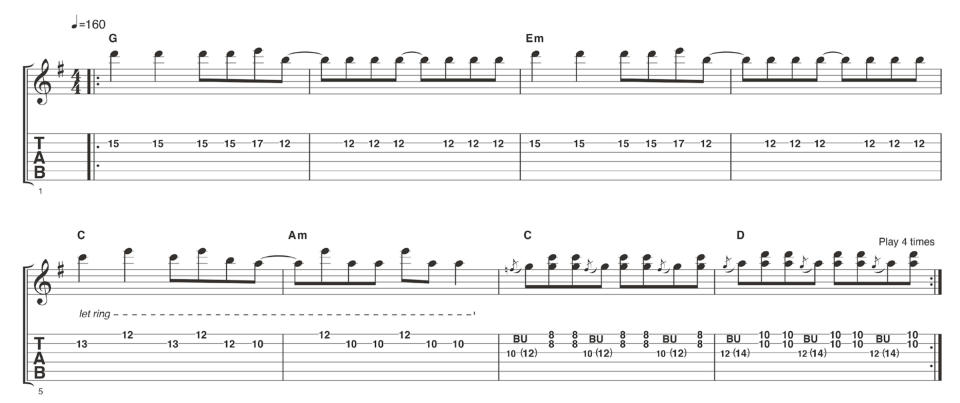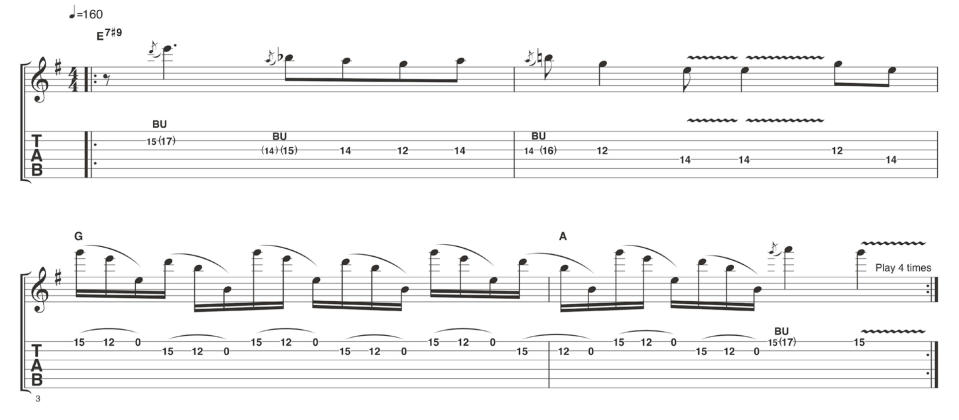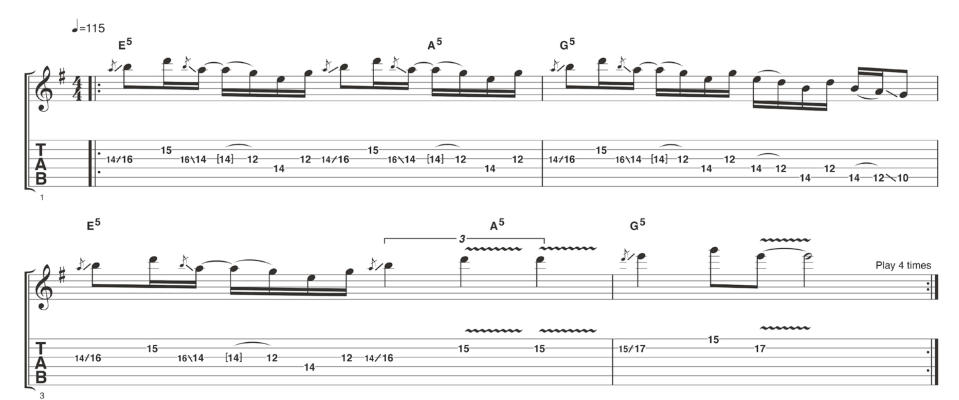The guitar solo is still in rude health – here’s what you can learn from today’s most exciting soloists

Over the following 15 examples, we are taking a whistle-stop tour through contrasting mix of musical genres of the 21st century, with the aim of identifying just what has made these styles and their solos so great.
Work through our tab examples and you too will soon be soloing with confidence in a variety of musical settings. We’ve ordered our examples roughly starting with the easiest to play, so why not challenge yourself to work through them all and see how far you can get?
To keep you on your toes we have used a variety of keys and time signatures, keeping our examples stylistically relevant to the tracks, bands and genres we’ve referenced for inspiration. For example, you can expect math-rock to use plenty of odd time signatures, so we have experimented with the unusual feel of 5/8 time.
For the more technically challenging examples you may need to start slowly before playing with the track. Of course, our tab lessons are intended as springboards for your own ideas, so if you find a technique or motif that you like here, try using it in your own solos.
Example 1. Garage rock

Our first example is inspired by garage rock acts of the early noughties, such as The Strokes. A simple catchy melody is played on the second string. When this hook line is repeated the chord changes, giving it a new lease of life. Our solo is finished off with some exciting sounding rock ’n’ roll style doublestops.
Bending the third string and playing a doublestop on the second and first strings is an idea that can be traced back to the early rock ’n’ roll guitar pioneers. The techniques we used for this example can be heard in the solos for songs like Last Nite and Barely Legal.
Example 2. Indie rock

Our next example is inspired by indie rock bands like Arctic Monkeys. The minor pentatonic scale can be heard in the solos for songs like Teddy Picker and I Bet You Look Good On The Dancefloor.
To maintain an even feel, try alternate picking the ascending A minor pentatonic line. Any C notes can be bent slightly sharp by a quarter-tone and this provides a bit of a blues-rock flavour.
Example 3. Progressive blues-rock

We’re referencing Jack White’s recent solo material here, with tracks like Fear Of The Dawn and What’s The Trick acting as our inspiration. A raspy fuzz tone is essential here.
The phrasing is inspired by classic blues-style ‘question and answer’ ideas. The main technique to concentrate on is the string bending intonation.
When practising the string bends first fret the D note (15th fret, second string) for reference and then try bending in tune from the 13th fret up to the D note.
Example 4. Uptempo Blues

Our next example is inspired by modern day blues heroes like Eric Gales. Eric is not shy of undertaking the odd Jimi Hendrix style wig-out, so this one is in the style of tracks like Rattlin’ Change. We’re using the E minor pentatonic scale at the 12th position, and any of the open strings can be included.
The main idea here is to pull off from the 15th fret to the 12th and then onto the open string in one motion. This creates a run of three notes that can be repeated as many times as required. In the key of E minor, this type of idea can be played on any string as long as the pentatonic scale shape is adhered to.
Example 5. Psych-rock

Today’s psych-rock boom is spearheaded by acts like King Gizzard And The Lizard Wizard and Mdou Moctar. Typically, there is often plenty of room for long passages of guitar soloing.
Repetition is key here, providing a hypnotic effect when done well. To provide that psychedelic swirl in our track we used a chorus effect with the rate on fast. You can also experiment with effects like a phaser.
Example 6. Roots rock

Blending elements of classic rock guitar and country guitar, Southern rock remains a traditional, rootsy style, with acts like Larkin Poe and Samantha Fish adding a modern slant.
For our example we are using some classic country-style doublestop bends. These bends can be supercharged by adding a bit of overdrive.
Example 7. Neo-soul

Here we’re taking inspiration from neo-soul maestro Tom Misch’s Disco Yes. The finger slide can be used to emulate the way a jazz saxophonist swoops into notes. To get this effect, simply slide into any note from a semitone below.
Palm-mutes provide a more percussive attack to popping lines. To get the all-important tone, try selecting the neck pickup on your guitar and also roll the tone control off a bit.
Example 8. Hard rock/metal

Often the heavier guitar styles are synonymous with guitar soloing, and here we look to bands Alter Bridge and Avenged Sevenfold for inspiration. Here, a wah pedal helps bring our lick to life, and the fast, descending run provides a nice challenge. We have used a churning 6/8 feel here so the count in is six clicks followed by a one-bar fill.
Example 9. Stoner rock/metal

Blues influences and, indeed, the blues scale are commonplace in stoner rock and metal, for example in Mastodon’s Teardrinker – and we’re in C blues here in our example.
The big bends can be tricky to execute, so if you are new to three-fret bends be sure to warm up first, and take care not to snap a string!
Example 10. Revivalist blues-rock

Inspired by Rival Sons’ Do Your Worst, we’re breaking out the bottleneck slide here. If you’re new to slide playing, make sure your slide is directly over the indicated fret –not behind it.
The other aspect of clean slide work is muting unwanted string noise. The fingers of both hands can rest on the strings as you play.
Example 11. Prog metal

The string-skipping technique can be used to provide ear-grabbing leaps in pitch. Here in our prog-metal style lick, inspired by Periphery’s Scarlet, we’ve linked the Em7 arpeggio to a Gmaj. Pointing the headstock towards the ceiling at 45 degrees can help with the ease of fingering.
Example 12. Uptempo country

Country often features high-octane solos with plenty of fast chickin’ picking. In our example we’re using ‘pick and fingers’-style hybrid picking as employed by virtuosos like Johnny Hiland. The same picking pattern is repeated to create a flowing lick. The picking pattern goes: downpick, hammer-on, then fingerpick the open string.
Example 13. Acoustic flatpicking

The flatpicking technique just means to use a plectrum as opposed to playing fingerstyle. Our example is inspired by the fast flatpicking abilities of guitarists like Molly Tuttle and Billy Strings. Notice how open strings are used to create a flowing, cascading lick.
Example 14. Virtuoso instrumental shred

For this example, we’re increasing the wow factor by introducing a bit of two-handed tapping – a mainstay of contemporary shredders like Plini and Guthrie Govan.
The idea here is to use a four-note-per-string fingering on the sixth, fourth and second strings. The first finger hammers on and is followed by fingers three and four.
Example 15. Math-rock

For this final example we’re using the rather math-rock time signature of 5/8, as used by Covet in songs like Lovespell.
To create a flowing line we have linked the Cmaj7 and Fmaj7 arpeggios. The string-skipping element makes these arpeggios easier to play in patterns, as opposed to just straight up or straight down.

